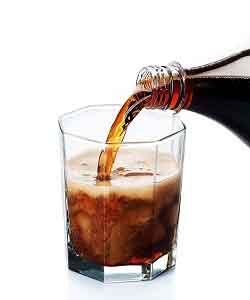
More evidence that low-calorie sweeteners are bad for your health
Studies show that artificial sweeteners can raise the risk of hypertension, metabolic syndrome, type 2 diabetes and heart disease, including stroke.

Natural Health News — A popular food colouring, used widely in soda, could raise your risk of cancer, according to a new report.
Public health researchers in the US have analysed soda consumption data in order to understand people’s exposure to a potentially carcinogenic by-product of some types of caramel colour in the US.
Caramel colour is a common ingredient in colas and other dark soft drinks. The results show that between 44 and 58% of people over the age of six typically have at least one can of soda per day, possibly more, potentially exposing them to 4-methylimidazole (4-MEI), a possible human carcinogen formed during the manufacture of some kinds of caramel colour. The results were published online today in PLOS One.
“Soft drink consumers are being exposed to an avoidable and unnecessary cancer risk from an ingredient that is being added to these beverages simply for aesthetic purposes,” says Keeve Nachman, PhD, senior author of the study and director of the Food Production and Public Health Program at the CLF and an assistant professor at the Johns Hopkins Bloomberg School of Public Health.
“This unnecessary exposure poses a threat to public health and raises questions about the continued use of caramel colouring in soda.”
In the UK we down 230 litres per person per year of sodas, the equivalent of around two 300ml cans per person per day. Just over half the sodas we consume are colas.
Building on earlier data
In 2013 and early 2014, Consumer Reports partnered with Johns Hopkins Center for a Livable Future (CLF) to analyse 4-MEI concentrations of 110 soft drink samples purchased from retail stores in California and the New York metropolitan area. This study pairs those results with population beverage consumption data from the National Health and Nutrition Examination Survey (NHANES) in order to estimate the population risks and cancer burden associated with 4-MEI exposures through soda.
While the 2014 study of the 110 samples of soda brands was not large enough to recommend one brand over another or draw conclusions about specific brands, results indicated that levels of 4-MEI could vary substantially across samples, even for the same type of beverage.
“For example, for diet colas, certain samples had higher or more variable levels of the compound, while other samples had very low concentrations,” says Tyler Smith, lead author of the study and a program officer with the CLF.
An unregulated toxin
While there’s currently no federal limit for 4-MEI in food or beverages, Consumer Reports petitioned the Food and Drug Administration to set limits for the potential carcinogen last year. It also shared the findings with the California Attorney General’s office, which enforces the state’s Proposition 65 law aimed at reducing consumers’ exposure to toxic chemicals.
Under this state law, any food or beverage sold in the state that exposes consumers to more than a specific amount of 4-MEI per day requires a health-warning label.
“This new analysis underscores our belief that people consume significant amounts of soda that unnecessarily elevate their risk of cancer over the course of a lifetime,” says Urvashi Rangan, PhD, executive director for Consumer Reports’ Food Safety and Sustainability Center.
“We believe beverage makers and the government should take the steps needed to protect public health. California has already taken an important step by setting a threshold for prompting Prop 65 labelling based on daily 4-MEI exposure from a food or beverage, such as a soda. This study sought to answer a critical question: How much soda do American consumers drink on average?”
Soda composition varies between US states
Researchers also found sharply contrasting levels of 4-MEI in some soft drinks purchased in the New York metropolitan area, versus California. “Our study also found that some of the soft drink products sold in California that we sampled had lower levels of 4-MEI than the samples we looked at of the same beverages sold outside the state, particularly in our earlier rounds of testing.
“It appears that regulations such as California’s Proposition 65 may be effective at reducing exposure to 4-MEI from soft drinks, and that beverages can be manufactured in ways that produce less 4-MEI,” suggests Nachman. “An FDA intervention, such as determining maximum levels for 4-MEI in beverages, could be a valuable approach to reducing excess cancer risk attributable to 4-MEI exposure in the US population.”

Please subscribe me to your newsletter mailing list. I have read the
privacy statement